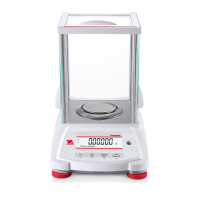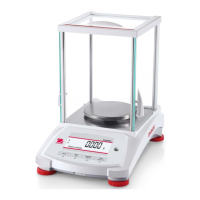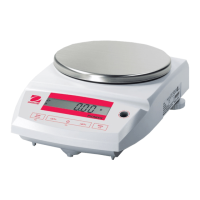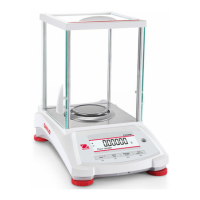Do you have a question about the OHAUS Pioneer PX323/E and is the answer not in the manual?
Read all safety warnings before installing, making connections, or servicing this equipment.
Be sure the balance is level before it is used or after its location is changed.
Connect the DC output connector to the power receptacle on the rear of the balance.
When the PX balance is first installed, or when it is moved to another location, it must be calibrated...
Describes the balance's core functions like weighing, taring, and zeroing.
Use this application to determine the weight of objects in the selected unit of measure.
Use this application to count samples of uniform weight.
Use Percent Weighing to display weight as a percentage of a pre-established reference sample.
Use this application to weigh unstable loads, such as a moving animal.
Use this application to determine an object's density.
Describes the procedure for weighing a solid submerged in water.
Describes the procedure for determining the density of a floating solid.
Describes determining density using a liquid other than water.
Describes determining liquid density using a calibrated sinker.
Describes determining the density of porous material using oil.
Details the three calibration methods available for PX balances.
Describes the calibration sub-menu specifically for InCal models.
Explains the process of internal calibration using the balance's built-in mass.
Explains span calibration using zero and full load points.
Details linearity calibration using three calibration points.
Sets the balance for Legal for Trade status, restricting certain functions.
Steps to perform before verification and sealing for LFT compliance.
Procedure for verification by authorized service agents.
Describes using a slide switch to secure menu settings.
Details methods for sealing balance settings to prevent tampering.
Guidance on periodically verifying and performing balance calibration.
Lists common symptoms, possible causes, and remedies for balance issues.
Read all safety warnings before installing, making connections, or servicing this equipment.
Be sure the balance is level before it is used or after its location is changed.
Connect the DC output connector to the power receptacle on the rear of the balance.
When the PX balance is first installed, or when it is moved to another location, it must be calibrated...
Describes the balance's core functions like weighing, taring, and zeroing.
Use this application to determine the weight of objects in the selected unit of measure.
Use this application to count samples of uniform weight.
Use Percent Weighing to display weight as a percentage of a pre-established reference sample.
Use this application to weigh unstable loads, such as a moving animal.
Use this application to determine an object's density.
Describes the procedure for weighing a solid submerged in water.
Describes the procedure for determining the density of a floating solid.
Describes determining density using a liquid other than water.
Describes determining liquid density using a calibrated sinker.
Describes determining the density of porous material using oil.
Details the three calibration methods available for PX balances.
Describes the calibration sub-menu specifically for InCal models.
Explains the process of internal calibration using the balance's built-in mass.
Explains span calibration using zero and full load points.
Details linearity calibration using three calibration points.
Sets the balance for Legal for Trade status, restricting certain functions.
Steps to perform before verification and sealing for LFT compliance.
Procedure for verification by authorized service agents.
Describes using a slide switch to secure menu settings.
Details methods for sealing balance settings to prevent tampering.
Guidance on periodically verifying and performing balance calibration.
Lists common symptoms, possible causes, and remedies for balance issues.











